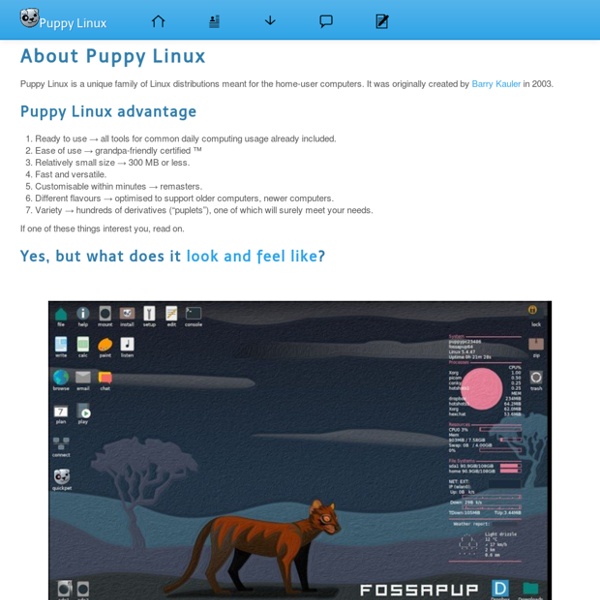



Slackware The Universal Operating System BASTILLE-LINUX KDE Puppy Linux Community - Home Download Latest Release → Quirky Xerus 8.1 for the Raspberry Pi is here! → Get Tahrpup (Ubuntu-Compatible) → Get Slacko (Slackware-Compatible) → Get Windows Installer (EXE installer) → Download old version * NEW * Quirky Xerus for the Raspberry Pi October 24, 2016 - Barry Kauler, creator of Puppy and Quirky Linux, released his latest Quirky Xerus version 8.1 for the Raspberry Pi. Quirky Xerus 8.1 for the Raspberry Pi is: built with Puppy Linux kit and Ubuntu 16.04 Xenial Xerus binary DEBs;a 360-MB Linux distro with LibreOffice, Inkscape, Seamonkey (Mozilla browser with composer), and many other applications;a fast GUI using JWM and ROX-Filer for the desktop;the first build by Barry Kauler for the ARM platform, specifically the Raspberry Pi 2 and 3;easy to install to micro-SD card, just decompress and write the IMG to 8-GB micro-SD card;available for download from ibiblio.org, nluug.nl and archive.org. Read this to explore the more technical aspects of Quirky Xerus. Slacko Puppy 6.3 desktop.
DSL information SliTaz SliTaz GNU/Linux is a light-weight, community-based Linux distribution suitable for use on older hardware or as a Live CD or Live USB.[3][4][5][6] System requirements[edit] SliTaz GNU/Linux is supported on all machines based on the i486 or x86 Intel compatible processors.[2] The Live CD has four variants of SliTaz, requiring from 192 MB of RAM for the Core system to 48 MB for a text mode and X Window System.[2] Slitaz can even run in 16 megabytes of RAM and a little swap memory. [7] SliTaz can be booted from a Live CD, Live USB, floppy disk, or a local area network,[8] or can be installed, requiring approximately 100 MB of hard disk space.[9] Release history[edit] Gallery[edit] See also[edit] References[edit] External links[edit]
hardware testing platform: About SliTaz GNU/Linux Windows PE 2.0: a tiny version of Windows for system maintenance Few people know it but when you boot off the Vista install DVD you’re booting into a different version of Windows altogether: Windows PE 2.0. It’s based on the Vista kernel but it’s extremely compact. It provides read/write access to NTFS filesystems a wide range of 32- and 64-bit hardware drivers network connectivity and the ability to run both 32- and 64-bit applications. However stripped away from the Vista installer it’s also a very versatile tool for administrators. It allows troubleshooting installation and system recovery and its small size means it can be run from CD USB key or even via network boot. PE has actually been around since the release of XP but most administrators have avoided using it instead preferring more mature third-party management and installation tools. The newest version of Windows PE (version 2.0) is different. How to get Windows PE Finding WinPE on your machine Building your own bootable WinPE 2.0 environment Booting and using Windows PE 2.0
Internet U.S. Army soldiers "surfing the Internet" at Forward Operating Base Yusifiyah, Iraq The Internet is a global system of interconnected computer networks that use the standard Internet protocol suite (TCP/IP) to link several billion devices worldwide. It is a network of networks[1] that consists of millions of private, public, academic, business, and government networks of local to global scope, linked by a broad array of electronic, wireless, and optical networking technologies. The Internet carries an extensive range of information resources and services, such as the inter-linked hypertext documents and applications of the World Wide Web (WWW), the infrastructure to support email, and peer-to-peer networks for file sharing and telephony. Most traditional communications media, including telephony and television, are being reshaped or redefined by the Internet, giving birth to new services such as voice over Internet Protocol (VoIP) and Internet Protocol television (IPTV). Terminology Users
Home Page | Puppy Linux Application software Application software is all the computer software that causes a computer to perform useful tasks beyond the running of the computer itself. A specific instance of such software is called a software application, application program, application or app.[1] The term is used to contrast such software with system software, which manages and integrates a computer's capabilities but does not directly perform tasks that benefit the user. The system software serves the application, which in turn serves the user. Application software applies the power of a particular computing platform or system software to a particular purpose. Terminology[edit] In information technology, an application is a computer program designed to help people perform an activity. Application software classification[edit] There are many different ways to divide up different types of application software, and several are explained here. There are many types of application software: Information worker software[edit] See also[edit]